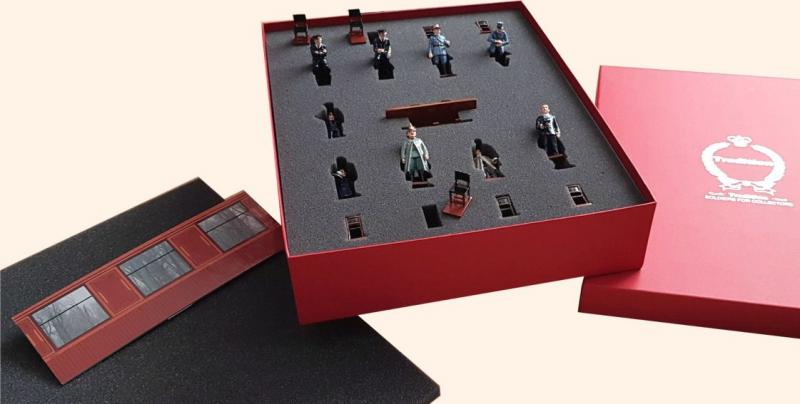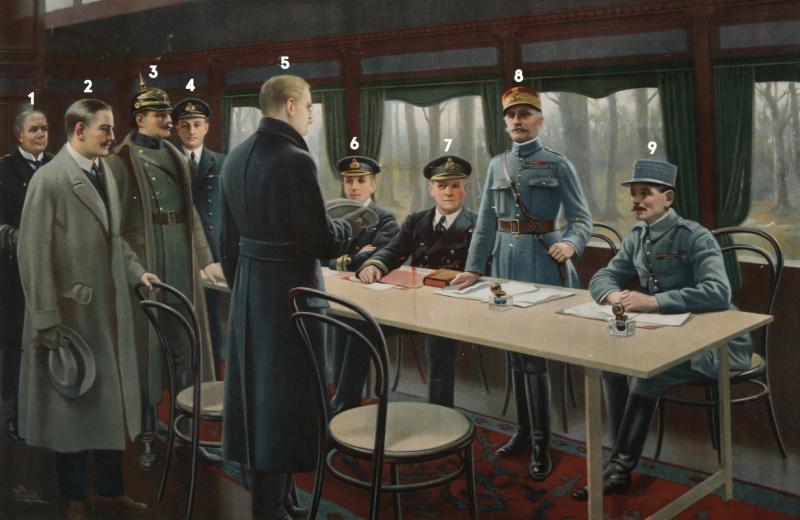Signing of the Armistice - WWI, Nov. 11, 2018--Special Order: Takes 2 to 3 months.
$350.00
Future Release
Add to Wish List Notify Me When Available
Item Number: TRAD826
#826 Signing of the Armistice Painted in Gloss
Depicting the momentous event that took place in the Forest of Compiègne on the 11th November 1918, the set includes all six signatories of the famous armistice that ushered in a ceasefire at the eleventh hour, of the eleventh day, of the eleventh month.
A worthy climax to any collection of First World War figures, the set comes complete with printed scenic backdrop to place the participants in their historic context.
Originally built in 1914 as a dining car for Compagnie Internationale Des Wagons-Lits (operators of the prestigious Orient Express), carriage No. 2419D was withdrawn from service in August 1918 and converted into a mobile office for the Allied Commander-in-Chief, Marshall Foch. Used by him from October 1918 to September 1919, it was later donated to the Musée de l'Armée as a monument to the Allied victory.
Painstakingly sculpted by the English artist, Andrew Stadden, the set’s figures are derived from a contemporary French print depicting the two delegations. Though giving the appearance of a colorised photograph, the original image is thought to be painting attributed to the French artist and decorator, Maurice Pillard Verneuil. (A small signature ‘Pillard’ is visible in the bottom left corner). The names of participants are correctly printed in French along the border, but the artist has incorrectly shown bentwood Thonet-style chairs, confirming it was not taken from an actual photograph.
In reality, the office refit included the bolt-to-the-floor furniture, and metal-studded leather and wood chairs that can be seen, both in other period sources, and in the reconstructed carriage itself, that still forms the centrepiece of the museum in the Clairière de l'Armistice, (The Glade of the Armistice).
Having acted as the stage set to conclude one world war, the original ‘Compiègne Wagon’ would see service in a second, being deliberately selected for the signing of the armistice marking the French surrender in June 1940. Turning the tables on the former victors, Adolf Hitler pointedly took his place in the very seat once occupied by Marshall Foch. Having savoured this symbolic act, the German authorities removed the carriage to Germany and destroyed the museum site, leaving only a statue of Foch to gaze over a wasteland.
1). Captain Ernst Vanselow - Imperial German Navy
2). Count Alfred Graf von Oberndorff - German Foreign Ministry
3). Major General Sigismund Detlof von Winterfeldt – Imperial German Army
4). Captain Jack P. R. Marriott – Royal Navy
5). Matthias Erzberger – German Secretary of State without portfolio
6). Rear Admiral Sir George P. W. Hope – Royal Navy
7). Vice Admiral Sir Ross Wemyss – Royal Navy
8). Marshal Ferdinand J. M. Foch – French Army
9). General Maxime Weygand – French Army


